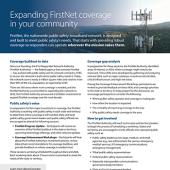The City of Chesapeake, Virginia, encompasses 353 square miles in the southeastern region of the Commonwealth, and it’s Bobby Gelormine’s job to make sure that the city is prepared to handle any emergency. As the Senior Planner for the Chesapeake Fire Department’s Office of Emergency Management, Gelormine helps the city plan for everything from hurricanes and flooding to terrorism and other man-made disasters. The city’s five police precincts and 15 fire stations are staffed by nearly a thousand public safety employees to protect its 240,000 citizens. Being in a constant state of readiness means that Gelormine and his colleagues across the City stay in close communication through the chain of command established in the emergency response plan.
A city-wide approach to communications
Establishing and maintaining communications has been made easier now that the city’s public safety agencies have adopted FirstNet. Police officers use the network to maintain connectivity in their patrol cars, and firefighters and medics rely on FirstNet in their fire apparatus and EMS monitors. The emergency management team uses FirstNet-enabled tablets to support their emergency management damage assessments in the field. Each of these agencies also equips staff with cellular devices on FirstNet to facilitate communications and coordination among first responders. Coverage inside public safety facilities has been boosted through the installation of metro cell equipment. “We rely on FirstNet to provide constant, uninterrupted, clear communications,” said Gelormine.
Putting the network to the test
Gelormine led the city’s transition to FirstNet and credits a close working relationship with the AT&T team and the First Responder Network Authority (FirstNet Authority) to handle any problems that crop up along the way.
“We were strategic in our switchover to FirstNet. We started with routers to see how the system handled the large amount of data that is shared between the city’s Emergency Communications Center and the field units,” he said. “Next, we began to switch out cellular devices for those that had city-issued phones in public safety. We meet with the FirstNet team once a month, now virtually, to talk about any issues, what’s going well, and what’s to come.”
The city’s public safety agencies tested and verified that FirstNet would provide the coverage and network services they needed to perform their critical and life-saving work before they signed on to the network. But it wasn’t until a recent event in June 2020 that the city’s first responders fully appreciated the benefits the network brings in terms of priority and preemption. Gelormine called it an “ah-ha” moment.
“Members of the community were taking part in a Civil March from a local church to City Hall, where members of the organization would speak along with public officials,” he said. “In order to ensure that those attending were safe, a drone was ‘bird perched’ on top of City Hall. The feed worked great, until the crowd of close to 1,000 came closer to City Hall. Many of the attendees were live-streaming the event, which caused signal errors for the drone operator. However, public safety using FirstNet had no issues with communications. We quickly realized that the UAV did not have a FirstNet-enabled router installed. This was an indicator to us that the use of FirstNet and Band 14 truly make a difference in communication.”
Data-informed decisions will shape public safety
The City is increasing its use of cellular devices on FirstNet, as well as investigating how a city-owned communications network asset like a Cell on Light Truck or Cell on Wheels could provide FirstNet coverage in challenging areas. Gelormine and his public safety colleagues say they will continue to advocate for FirstNet.
“You have to be willing to look at the data and scrub out the noise of the competition. Take the opportunity to break the resistance to change and be a pioneer for your agency. Let a federally-backed system with a 25-year roadmap to reinvest in the network help you lead the way. We had the tough discussions with FirstNet when the city was considering switching to the network. The representatives in the room made a promise, and they have kept that promise to this day.”
Gelormine says the key to his agency’s success can be, and should be, replicated by other emergency managers. “Take the time to reach out to other localities or agencies that have made the switch and let the data help you make an informed decision,” he said. “Communication in its many forms is the cornerstone to effective leadership, policy, and operations. AT&T and the FirstNet Authority have helped us succeed in our vision, and have listened as we continue to build for the future.”




















